The three best alternatives to box for simple topiary
There are only a few good alternatives to box (English boxwood or Buxus sempervirens) for topiary.
But I have just visited a delightful private garden in Kent which shows off both box and the best box substitutes absolutely beautifully.
With the box tree moth caterpillar currently munching its way through gardens everywhere, this problem is not going away. Many garden designers now avoid using box at all, when planting up gardens.
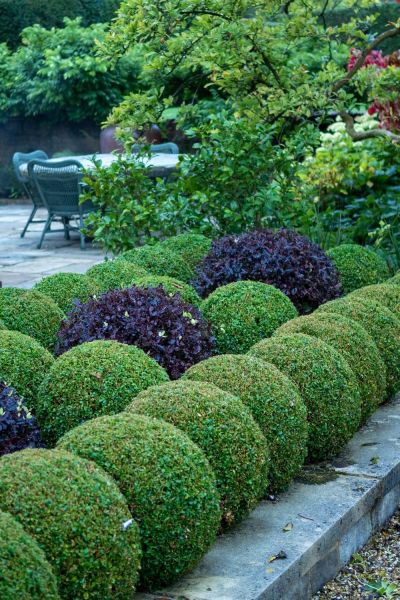
I’ve asked the head gardener of this beautiful garden in Kent, Jim Treby, about alternatives to box for topiary and hedging. The garden has a lot of box, but he is building up evergreen structure with other plants. The purple ball here is Pittosporum ‘Tom Thumb.’
Even if you don’t have box blight or box tree caterpillar where you live, there are great advantages to finding alternatives to box for your topiary and low hedging structure.
Firstly, the different leaf colours make a really good contrast, as you can see below (and above!).

Here a box cone and a low hedge of Japanese holly (Ilex crenata), often recommended as a substitute for box have contrasting leaf colours. Japanese holly is not, however, in our top three alternatives to box (see later on!). The RHS has also found that Ilex crenata is a disappointing alternative to box.
And secondly, if a pest or disease does come along, a good mix of different shrubs will help stop the spread. Having lots of the same plant in one garden can mean that one pest or disease can devastate the garden. Diversity is the key to good health.
This beautiful private garden has been planted with lots of box topiary over the years. And it’s had a brief brush with both box blight and the box tree caterpillar.
But Jim has got it under control, partly by finding alternatives to box and partly by treating the few affected plants they did have.
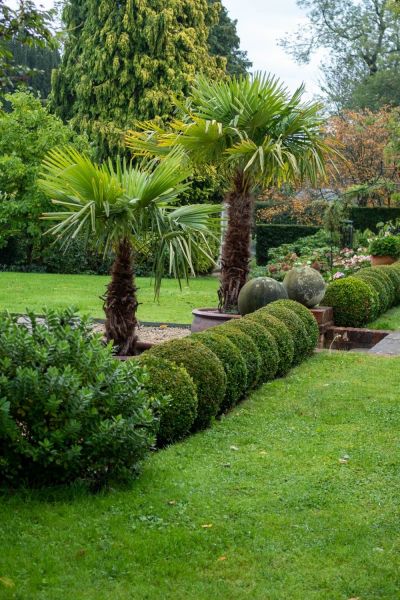
Rows of box balls and two palm trees add punctuation to a change in levels. This is a garden which looks good all year round because it has such a strong evergreen structure. But those box balls are a key part of it, so Jim is slowly introducing more alternatives to box.
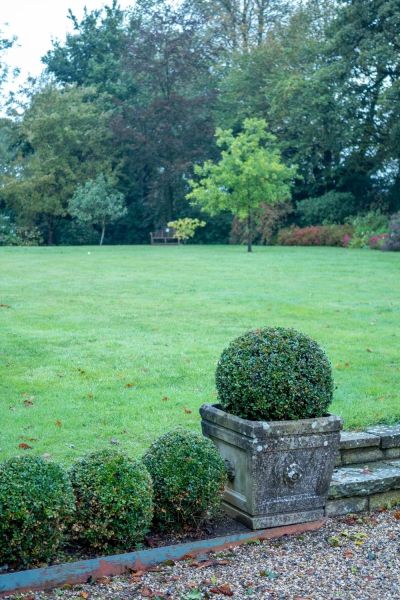
And on the other lawn, box balls in a row and in pots are used to edge and frame the lawn, giving it a classical feel.
Alternatives to box for topiary and low clipped hedging
- Yew – the number one alternative to box
- Pittosporum
- Euonymus
- Viburnum tinus (rounded shapes only)
- Privet (but it’s fast growing so needs clipping regularly)
- Holly, including Ilex crenata (with warnings…)
How do I know if I’ve got box moth caterpillar?
You’ll see brown patches of dead leaves in your box plant. You should also look for fine, white spider-web type webbing, and green caterpillars with a yellow stripe.
Sometimes the whole box plant dies. Find out more about how to spot box tree moth caterpillar here.
Yew is the best alternative to box
Jim says that yew (Taxus baccata) is by far the best alternative to box for topiary and low hedges. ‘People think of it for grand gardens and big hedges,’ he says. ‘But it can be cut quite low and into any shape you want. You can prune it as hard as you like and it will grow in any soil. It doesn’t like its roots sitting in wet soil, but otherwise it’s very robust.’
If you want vertical shapes, he recommends Irish yew, which is grows up in a narrow, tight fastigiate column. If you want balls, spirals, boxes or low hedging, then buy English yew.
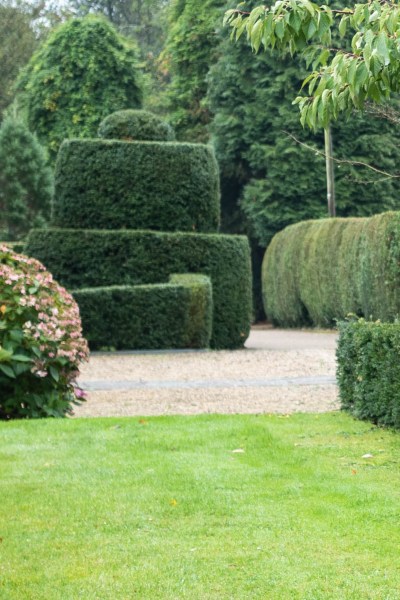
These yew hedges and topiary are substantial, but Jim says that yew also clips neatly into smaller shapes. There are photographs to show that the spiral on the left was a planted in late Victorian times, when it was quite small and a completely different shape.
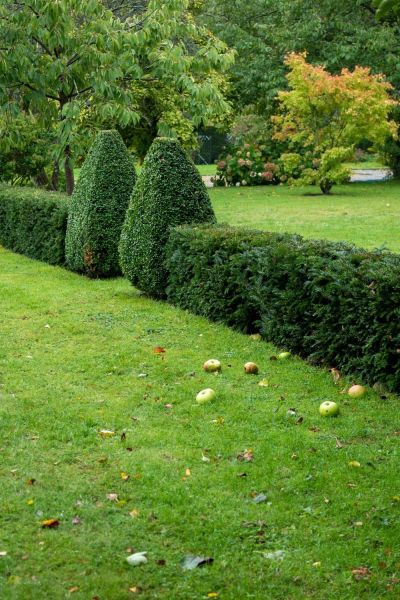
This low yew hedge is about three years old and clips into a beautiful tight shape. Not all plants do well if clipped back regularly for topiary.
Jim recommends buying root-balled yews at least 60cm-80cm tall. Root-balled means they are dug up from the field, with soil around their roots. They are wrapped in some kind of sacking or similar material. Cut them back when you have planted them if you want them shorter. ‘For some reason, planting pot grown yews under 60cm often has a high failure rate,’ he says.
In second place – pittosporum
‘If you want large topiary balls, I’d choose pittosporum,’ says Jim. ‘It’s another fantastic evergreen plant. It doesn’t have many pests or diseases – just occasional leaf spot which can be treated very easily.’
You can prune pittosporum back hard and it’s drought tolerant. ‘However, it is quite vigorous,’ he says. ‘You can clip box once a year, preferably in July/August so that new growth hardens off before the frosts. But yew and pittosporum both need clipping twice a year, in spring and autumn.’
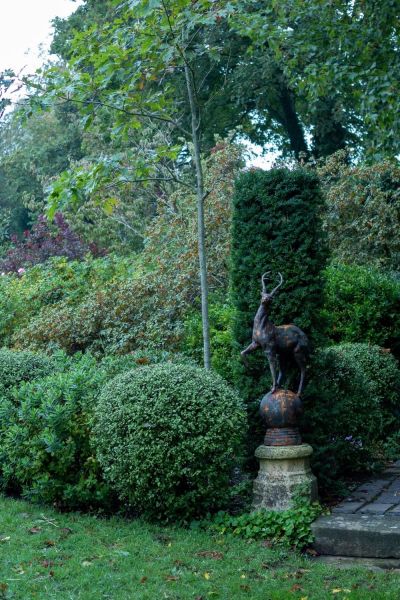
A narrow clipped yew hedge and dark green balls of Pittosporum (Pittosporum tenuifolium ‘Cratus’) work well together in this corner.
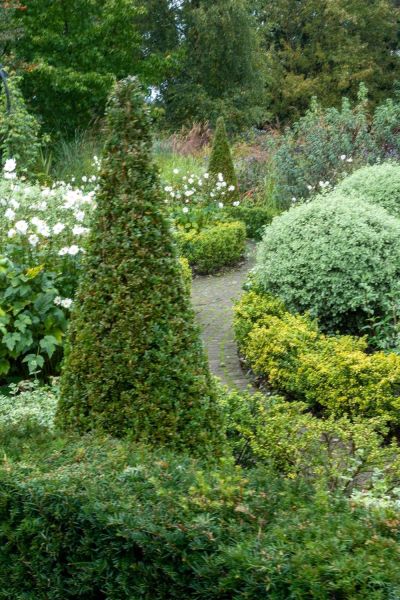
This part of the garden features clipped grey-green Pittosporum balls (Pittosporum tenuifolium ‘Eugenoides variegatum’), low Ilex crenata hedges, a yew hedge in the foreground and a box cone. The contrast in leaf colour is delightful.
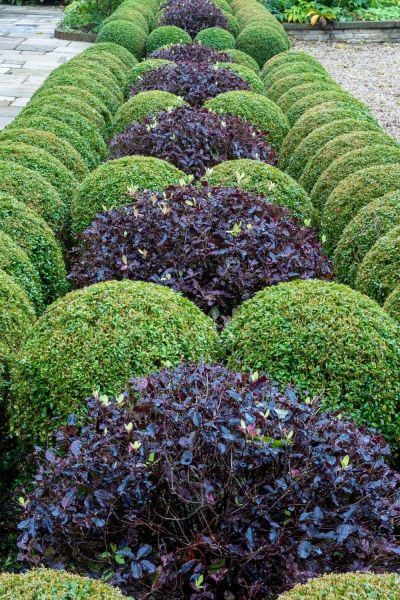
Contrasting with box balls – purple red Pittosporum tenuifolium ‘Tom Thumb’ in its autumn foliage. In spring, it is a fresh green.
When buying pittosporum, Jim recommends you check that the plant isn’t pot bound. Slip it out of its pot to make sure that the roots haven’t formed a tight mat against the side of the pot. This is called ‘pot bound’ and pot bound plants often fail to thrive as their roots don’t spread out into the soil in the right way.
Pittosporums can also be slightly frost tender, so don’t plant them in a frost pocket. If you have a hard frost forecast, Jim recommends that you throw a horticultural fleece over them.
Pittosporum also emerged well in the RHS trials of alternatives to box. Podocarpus also emerged well out of these trials. It, too, can be somewhat frost-sensitive, although it’s usually fine in most UK winters and USDA zones 8-11. That means it tolerates temperatures a few degrees below zero, but probably wouldn’t survive a long, harsh, snowy winter.
Alternatives to box – euonymus
Euonymus is the third best alternative to box, says Jim. Like Pittosporum, it comes in a number of different varieties with shades from grey-green to yellow-green.

Euonymus is a good alternative to box. This shows Euonymus Emerald & Gold (top) and Euonymus ‘Emerald Gaiety’ (silver-leafed, above).
Euonymus tend to be pest and disease-free, says Jim. But they can lose their leaves in very cold winters, although they re-grow again the following spring. It’s a slow growing plant and will take a little time to form into a low hedge or shape.
Three alternatives to box you may want to avoid
There are three other plants that can work as alternatives to box for simple topiary, but Jim has reservations about them.
Japanese holly (Ilex crenata)
Firstly, Japanese holly (Ilex crenata) has often been recommended for topiary, because it looks so like box. It has small leaves and can be clipped into shapes. But Jim says that he finds that it has a looser habit. ‘You won’t get the tight, compact topiary you would get from yew or box.’
It doesn’t thrive in this garden, although it’s supposed to do well in any soil. Jim says that it’s also quite expensive, so personally he wouldn’t buy it again.
Early results of trials with the RHS confirm this – it didn’t emerge as good a substitute for box as everyone hoped.
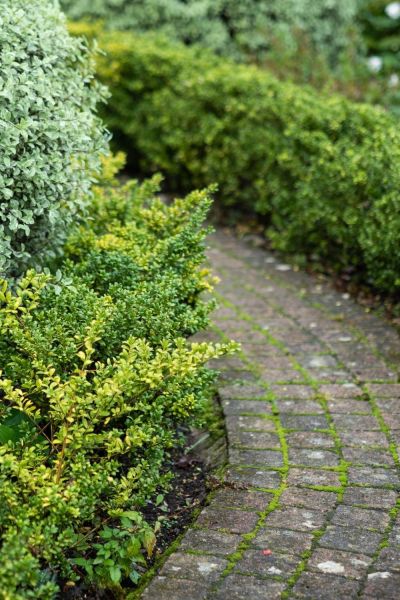
This Japanese holly (Ilex crenata) isn’t as good for a tight, clipped shape as yew is. Jim says it doesn’t seem to get its roots as well as established and can look scrappy.
Privet (Ligustrum ovalifolium)
Secondly, privet (Ligustrum ovalifolium) can be clipped into shape. I’ve got two privet lollipops in my garden and they are a very affordable way of having topiary.
But Jim warns that privet is very fast-growing, so you would need to clip it three times a year. I agree with him. It’s fine for me to clip two little standards three times a year, but if I had any more privet it would be too high maintenance.
Viburnum tinus
Thirdly, there is Viburnum tinus. This is seen here by the steps in Jim’s garden (see below) and it looks great clipped into lollipop shapes. But he says that it is only good for a rounded shape and couldn’t be clipped into cones or spirals.
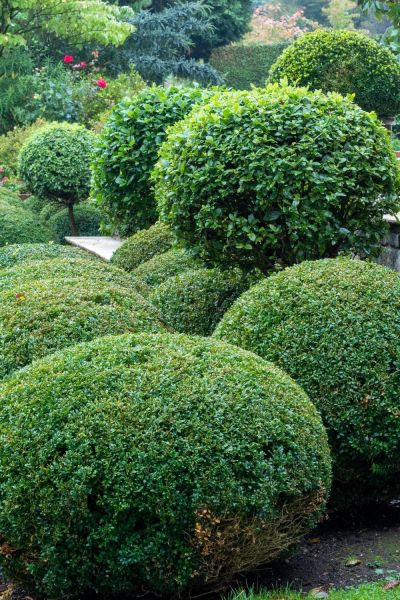
The balls in the front are box. Behind them is Viburnum tinus, which look great clipped as rounds, but which would be no good as cones or spirals. The little brown patch on the edge of the front box ball is due to the dog cocking its leg, not to blight. That’s worth thinking about if you have male dogs and want to have box topiary or hedging close to the ground!
Stylish clipped shaping for a conifer hedge!
There is a clipped conifer hedge in this garden which is made of two contrasting conifers. The main run of the hedge of Cypress Leylandii, kept clipped regularly. Slightly paler Thuja occidentalis are planted in front of it, and also clipped to shape. It makes a stylish contrast.
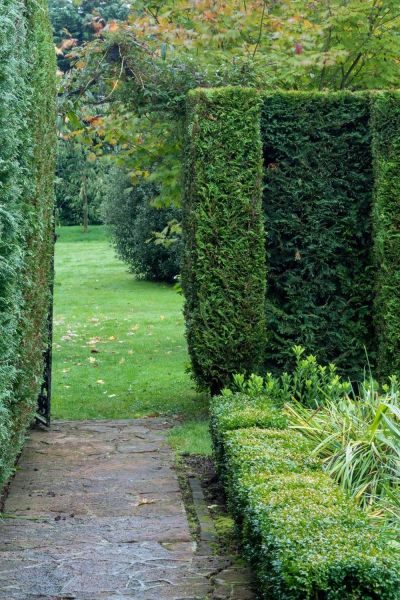
This smart hedge is made of Cypress leylandii with Thuja occidentalis planted as ‘buttresses’ in front of it. Such a great treatment for a hedge.

I love the leaf contrast between these two conifers. Thuja is easy to clip as it grows out of old wood. You have to keep Leylandii cypresses cut regularly. Once they’re out of control, you can’t clip them back because they won’t re-grow from old wood.
I’ve seen another private garden using this technique with conifers, with an even greater contrast in colour. It’s a garden that is mainly planted with evergreen shrubs and trees, so it has lots more inspiration for creating an evergreen garden for year round interest.
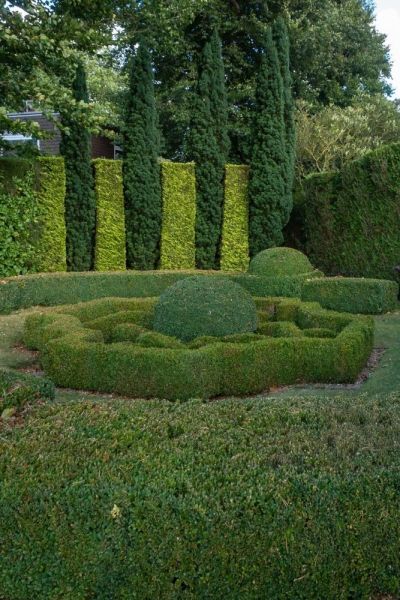
Roger Lloyd and Stephen Sendall used strongly contrasting golden cypress and dark green Irish yew to achieve this effect.
Is topiary expensive?
Large topiary items are expensive. They can cost thousands just for one plant.
But it’s not too difficult to cut shrubs and trees into shape yourself and that will save lots of money. If you’re prepared to ‘grow your own’, you can achieve very similar effects at an affordable price. I have lots of topiary in my own garden. How to buy sensational topiary on a middle-sized budget will show you how.
My friends, Robbie and Diane Perry have also created a stunning topiary garden. They’ve kept it easy by using simple shapes. See how to use easy topiary shapes in stylish ways to find out how.
Growing topiary yourself takes time, which is why buying big topiary pieces costs so much. But in 3-5 years, you can create really dramatic effects of your own.

The top garden is mine. We bought the two pom-pom trees as young whips and shaped them over 5 years. The garden below it belongs to Diane and Robbie Perry who combine simple shapes to create low-maintenance, stylish effects.
Treatments for box blight and box moth caterpillar
If you want to avoid box blight, make sure you buy your box from specialist, preferably local suppliers who know they haven’t got it. Or grow your own from cuttings. Never borrow other people’s shears or other equipment.
But as the box tree moth caterpillar can fly, these measures are less effective against it.
You can buy effective chemical treatments against both box blight and box tree moth caterpillar. But the most effective treatments need a licence. So amateur gardeners generally don’t have access to these. Jim has a licence, so he uses a pesticide called Bandu against the caterpillar and a fungicide called Signum against the blight.
There are also treatments available for domestic gardeners. The RHS has a page of advice on preventing and treating box blight for amateur gardeners.
You can also engage companies to carry out professional treatments. Jim used to work for one of them – Bartlett Tree Services.
See this really pretty garden in video
You can see much more of this really beautiful garden in this video, along with Jim’s interview. It really is worth watching (I think!)
Shop my favourite gardening products, books and tools
I’m often asked for recommendations so I’ve put together lists of the gardening products, books and tools I use myself on the Middlesized Garden Amazon store. Note that links to Amazon are affiliate, so I may get a small fee if you buy, but I only recommend things I genuinely use myself!
For example, there is a topiary book and the shears I (and many professional gardeners) use in the Create Your Own Topiary list here.
And there is more about using easy topiary shapes in stylish ways to give your garden evergreen structure here. Plus there are money-saving tips for buying topiary here.
Pin to remember alternatives to box
And do join us every Sunday morning for more gardening tips, ideas and inspiration. See here to follow by email.

























Great post and well researched as always! I’ve had great success with Teucrium leucidrys for dwarf hedging, after failing twice with Ilex crenata (I don’t know anyone with a good word to say for Japanese Holly!). But I put in some pittosporum last year which didn’t make it through the winter, and I don’t think I’m the only one to experience this. I’ve replaced it in the hope that last year was exceptional in its lethal sequence of drought, cold, and wet.
I think you’re right – I’m not 100% certain but fairly sure that the pittosporum in the trials at RHS Wisley also failed to make it through last winter, although they are in a frost pocket and last winter’s exceptional wet autumn and early freeze was unusually lethal.
Great research .Rather rely on you than Gardeners World BBC
Ah, thank you!
You are so helpful….I have referred to your video & article many times as topiary & information is scarce in America!
Thank you!
This is a really interesting article, thank you Alexandra. I have a much loved box garden but have been treating box blight in the last year (with some success) and wondering about alternatives if I have to lose it. It looks like Yew might be the best replacement.
Oh dear, I had hoped that we were being spared the box blight but I know you’re based quite close to where I am, so if you have got it, I will be next. I’m just not buying any more box and hoping that the garden walls will keep moth and blight out. It may be a sorry hope…
Great photos with the text that gave me lots of use was and information. Thank you.
Thank you.
Thank you – most informative
Really interesting blog and very useful to know the pros and cons of the alternative to buxus. Great video too!
Thank you!